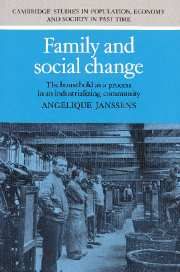Book contents
- Frontmatter
- Contents
- List of figures
- List of tables
- List of appendices
- Preface
- 1 Family and industrialization
- 2 The industrializing context: continuity and change in nineteenth-century Tilburg
- 3 Sources and methods
- 4 Family structure through time
- 5 Family life and the social structure
- 6 Family structure and geographical mobility
- 7 Family and work: the effect of the family economy on the structural characteristics of the household
- 8 Conclusion
- Appendices
- Bibliography
- Index
- Cambridge Studies in Population, Economy and Society in Past Time
1 - Family and industrialization
Published online by Cambridge University Press: 05 March 2012
- Frontmatter
- Contents
- List of figures
- List of tables
- List of appendices
- Preface
- 1 Family and industrialization
- 2 The industrializing context: continuity and change in nineteenth-century Tilburg
- 3 Sources and methods
- 4 Family structure through time
- 5 Family life and the social structure
- 6 Family structure and geographical mobility
- 7 Family and work: the effect of the family economy on the structural characteristics of the household
- 8 Conclusion
- Appendices
- Bibliography
- Index
- Cambridge Studies in Population, Economy and Society in Past Time
Summary
Industrialization is widely seen as the most important social and economic change of the last 200 years; it is frequently credited with the power to modify or destroy any pre-existing social arrangement that stands in its way. In particular, there is often assumed to be an adversarial relationship between the traditional extended family and the process of industrialization. In this chapter I examine this long held belief, focusing on the origins of this idea and the contributions to it by the great theorist of structural-functionalism, the American sociologist Talcott Parsons. I shall then try to trace the formulation of new hypotheses resulting from empirical historical research concerning the relation of family to industrial society. After that I proceed to the formulation of the questions that have guided the present research.
Traditional family theory
Until the later 1960s virtually all historians and sociologists subscribed to the popular tradition of the large preindustrial extended family. Before industrialization and urbanization, it was believed, people lived together in large households with great numbers of relatives and servants. The world we lost as a result of industrialization consisted of households engaged in a wide range of functions of which the economic function was most important. The household was the locus of many productive activities in which all household members participated. Individual aspirations in the traditional household were made subject to the stability and the material interests of the family group.
- Type
- Chapter
- Information
- Family and Social ChangeThe Household as a Process in an Industrializing Community, pp. 1 - 30Publisher: Cambridge University PressPrint publication year: 1993
- 1
- Cited by

